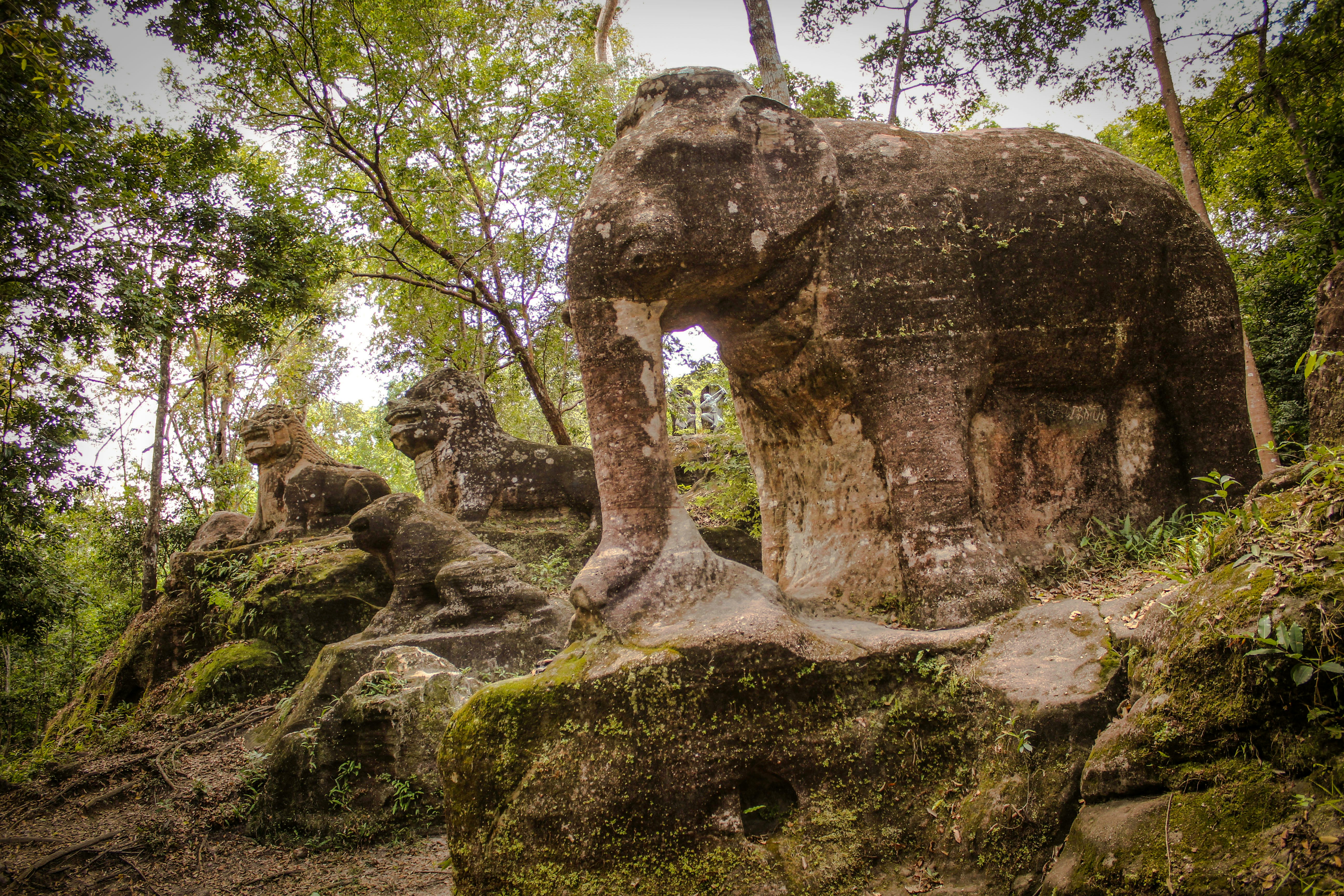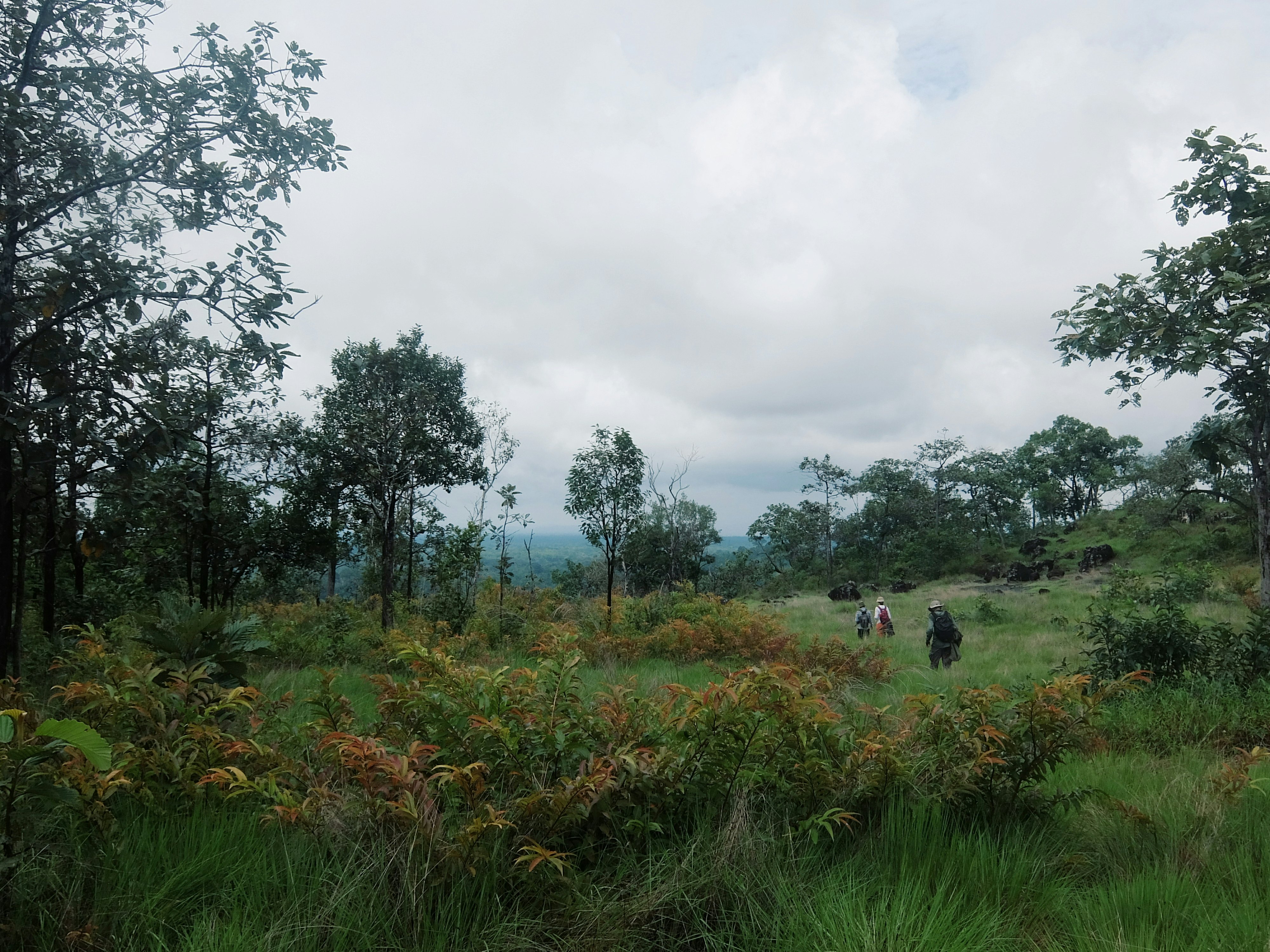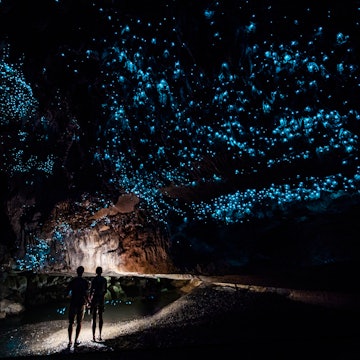

Wat Sampov Bram at Bokor. Darren Wilch/500px
Nick Ray is the author of the Phnom Penh and Siem Reap chapters of Lonely Planet's Cambodia guidebook, which was published in September 2025.
Cambodia is world-famous for its ancient temples, but the country also has an extensive system of national parks and protected areas, covering around 40% of the land and providing a vital haven for a vast variety of wildlife.
Sprawling over 4104 sq km, Southern Cardamom National Park is the largest protected area in Cambodia, and it forms part of the magnificent Cardamom Rainforest Landscape, which encompasses 11 contiguous reserves totaling more than 20,000 sq km of the country's southwest.
Other national parks that see plenty of visitors include Phnom Kulen National Park near Siem Reap, Bokor National Park near Kampot and Kep National Park near Kep. Hiking and camping in the national parks has taken off among locals, particularly in Kirirom National Park and the Cardamom Mountains.
For travelers who fancy a dose of nature alongside temples and other top attractions, here's our guide to the best national parks in Cambodia.

1. Phnom Kulen National Park
Best for temples
The sacred mountain of Phnom Kulen was the birthplace of the Khmer Empire. In 802 CE, this was where King Jayavarman II proclaimed himself a devaraja (god-king) and the earthly representative of the Hindu god Shiva. The summit is still an important place of pilgrimage for the Cambodian people, and the surrounding national park is one of the most visited reserves in the country.
Attractions include an iconic waterfall (featured in the original Lara Croft: Tomb Raider movie), the mysterious Kbal Spean (River of a Thousand Lingas) and the 16th-century reclining Buddha of Preah Ang Thom. The extensive forests that cover the plateau also hide the remains of the lost city of Mahendraparvata, the former capital of Jayavarman II, which lay forgotten beneath the jungle for a millennium or more.
Hiking trails are not yet well developed at Phnom Kulen, though community-based ecotourism projects in Anlong Thom are opening up some pristine areas of the mountain to trekkers. This is arguably the most rewarding park to explore in Cambodia, thanks to the wealth of archaeological relics beneath the jungle canopy.
2. Keo Seima Wildlife Sanctuary
Best for wildlife
One of the most biodiverse areas in northeast Cambodia, the Keo Seima Wildlife Sanctuary has an estimated 20,000 black-shanked douc monkeys and 1000 southern yellow-cheeked crested gibbons, according to a Wildlife Conservation Society study. These are the world’s largest known populations of both species.
Jahoo offers the chance to trek into the wild to see these rare primates, along with other elusive animals, as part of an innovative project to provide local villagers with sustainable income as an incentive to conserve these endangered primates and their habitat. Walks wind between mixed evergreen forests and waterfalls, with an excellent chance of spotting doucs, macaques and sometimes gibbons along the way.
You'll need to be up before dawn to catch these skittish creatures, so sleeping at the camp is highly recommended. A conservation contribution is included in the cost of the trip, which supports local community development projects.

3. Kirirom National Park
Best for forest scenery
Although it lies just 3 hours southwest of Phnom Penh, lush, elevated Kirirom National Park creates a chance to really get away from it all. Winding trails lead through pine forests to cascading wet-season waterfalls and exposed cliffs with incredible views of the Cardamom Mountains. And there’s some great mountain biking in this rugged landscape if you’re feeling particularly adventurous.
Back in the heady days of the 1960s, when Cambodia was a peaceful and stable oasis, Kirirom was earmarked as the site for a new mountaintop city called Tioulongville, but civil war and genocide put an end to the plans. The remains of several old mansions can still be seen around the forest, including one built for former King Norodom Sihanouk.
One of the best hikes is the 14km trail up Phnom Dat Chivit (End of Life Mountain), where an abrupt cliff face offers an unbroken view of the Elephant Mountains and the Cardamom Mountains to the west. Homestays and community-based hiking programs provide plenty of chances to steer tourist income to local communities.
4. Botum Sakor National Park
Best for conservation activities
Encircled by mangroves and beaches, Botum Sakor National Park holds a profusion of wildlife. Though their habitat is fast disappearing because of major development in the area, you can still enjoy some world-class ecotourism activities at Cardamom Tented Camp, located in the heart of Botum Sakor on the banks of the wildlife-filled Prek Tachan River.
The camp is a fine model of how to do ecotourism successfully and one of the most charming and beguiling overnight stays you'll find anywhere in the region. Sophisticated safari tents supply guests with creature comforts while they participate in practical conservation activities such as forest patrols and tree planting. Hiking and kayaking trips are also popular diversions, offering the chance to spot gibbons, otters and countless species of rainforest birds.

5. Virachey National Park
Best for remote wilderness
One of Cambodia's largest protected areas, Virachey National Park stretches for 3325 sq km, running east toward Vietnam, north toward Laos and west into Cambodia's Stung Treng Province. The park has never been fully explored and is home to many rare mammals, including Asian elephants, clouded leopards and sun bears. Chances of seeing any of these creatures are slim, but you’ll probably hear endangered gibbons, and you may spot great hornbills, giant ibis and other rare birds.
The park plays such a vital role in the biodiversity of the Mekong region that it was designated an ASEAN Heritage Park in 2003. It's only possible to visit on an organized hike booked through the Virachey National Park Eco-Tourism Information Center in Ban Lung, 330km northeast of Phnom Penh.
The program aims to involve and benefit local communities, with activities such as 2- to 8-day hikes led by English-speaking rangers. The Phnom Veal Thom trek is a 7-day, 6-night expedition that goes deep into the heart of the grasslands, an area rich in wildlife, with regular sightings of sambar deer, gibbons, langurs, wild pigs, bears and hornbills.
6. Peam Krasaop Wildlife Sanctuary
Best for mangroves
The magnificent mangroves of this 260-sq-km sanctuary, anchored to a series of alluvial islands, protect the coast from erosion; act as a hatchery and nursery for fish, shrimp and shellfish; and provide a home for myriad birds. To get a feel for this delicate mangrove ecosystem – the largest in mainland Southeast Asia – head to the park entrance, where a mangrove walk wends its way above the briny waters to a 15m observation tower.
You can hire a motorboat to take you through the sanctuary at water level, visiting fishing hamlets and some of the more remote mangrove islands, which have isolated beaches to relax on. Much of Peam Krasaop is on the Ramsar list of wetlands of international importance. The area is all the more valuable from an ecological standpoint because similar forests in Thailand have already been trashed by short-sighted development.

7. Bokor National Park
Best for panoramic views
The abandoned French hill station of Bokor, now part of Bokor National Park, is renowned for its refreshingly cool climate and derelict buildings that enjoyed a heyday during the 1920s and 1930s. On cold, foggy days, it can get pretty haunting up here as mists drop visibility to almost zero and the wind howls through the decaying buildings. When the weather is clear, Bokor offers stunning views over the coastal plain, some 1000m below.
Despite a giant casino hotel and housing development that have destroyed some of the charm, the setting is still impressive, and the dense rainforests of this 1581-sq-km park shelter an incredible array of wildlife. The best-known attraction is the crumbling Catholic Church, which looms eerily out of the mist on a cool day. It's also worth exploring Wat Sampov Bram, named after the five boats it is said to resemble, and Popokvil Falls, one of the more impressive wet-season waterfalls in the area.
8. Southern Cardamom National Park
Best for community-based ecotourism
The largest national park in Cambodia, at 4104 sq km, Southern Cardamom National Park is home to more than 50 species listed on the IUCN Red List of Threatened Species, including Asian elephants, sun bears, gibbons and pangolins.
A dedicated team of rangers and military police patrol this vast area, which is spread across four provinces: Koh Kong, Pursat, Kompong Speu and Kompong Som (Sihanoukville). Ecotourism is having a very positive impact in the region, with Koh Kong city serving as the jumping-off point for community ecotourism programs in the Areng Valley and Osoam.
The Areng Valley is one of the most remote and wild regions of the Cardamom Mountains, and it's the setting for a Wildlife Alliance–supported initiative to promote hiking in this stunning landscape, which has one of the last remaining wild populations of Siamese crocodiles.
Southern Cardamom National Park is also a western access point to the impressive Khnong Phsar grasslands.

9. Kep National Park
Best for gentle hiking
Kep National Park looms large over the popular seaside town of the same name, offering easy access to nature. The park, one of Cambodia's smallest protected areas, includes an 8km circuit trail, navigable on foot or by mountain bike or motorcycle, which starts behind Veranda Natural Resort. The Stairway to Heaven Trail is a highlight, leading up the hill to a pagoda, a nunnery and the popular Sunset Rock viewpoint.
From the Bopha Prasidh Ave perimeter road, there are immense views over the Cambodian coastline and the island of Phu Quoc in Vietnam.
10. Phnom Aural Wildlife Sanctuary
Best for mountain peaks
Standing tall in the northeast corner of the Cardamom Mountains, this 2538-sq-km sanctuary contains the country's highest peak, Phnom Aural, which tops out at 1813m. More of a trek than a climb, ascending Phnom Aural definitely does not require mountaineering experience. The mountain can be conquered in a day, but most visitors take 2 days, with an overnight stop near the summit.
There are also a number of remote waterfalls around the mountain, and plans to develop walking trails and visitor facilities are part of the Cambodia Sustainable Landscape and Ecotourism project, supported by the Ministry of Environment and the World Bank.














